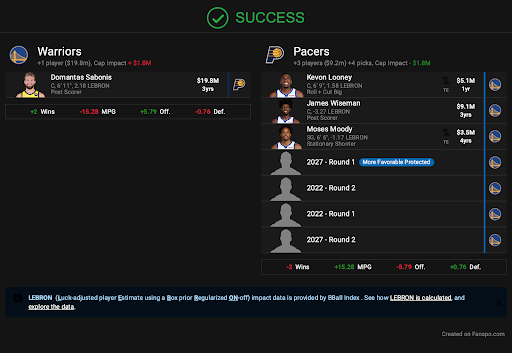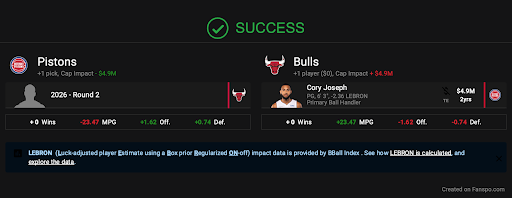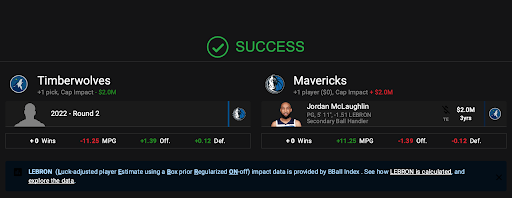-
 February 8, 2022, 12:40 am
February 8, 2022, 12:40 amLast Updated on February 8, 2022 12:42 am by Mike Passador | Published: February 8, 2022
The 2022 SportsEthos Mock Trade Deadline is in the books! I would like to thank all 14 of the other GMs who helped me out and made this possible. If you haven’t yet seen part one, click here.
We’ve already seen a couple trades go down, such as the Clippers-Blazers swap, along with the Caris LeVert to the Cavaliers trade. Now, I don’t expect these mock trades to be accurate, but there are some things for me to take early victory laps on. It is still early, and a plethora of moves may and likely will go down by Thursday. But when everybody zigged on the Clippers cutting back money, I zagged and had them trading for John Wall. While they still may very well trade a Marcus Morris type for an asset and tax relief, they added Norman Powell’s five-year deal onto their books, as well as Robert Covington’s Bird Rights heading into unrestricted free agency.
Further, while we had the Cavs adding a wing, it was the wrong wing. In part one of this article, we saw the Cavs add Eric Gordon in a five-team trade. In reality, it always seemed like Caris LeVert was their primary target from the get-go. Alas, here’s part two of our mock trade deadline:
PACERS BLOW IT UP, PART ONE
Grizzlies get: Caris LeVert and 2023 second-rounder from Charlotte (via Boston)
Hornets get: Myles Turner, Jeremy Lamb, and Jarrett Culver
Pacers get: Gordon Hayward, Kyle Anderson, 2022 first-rounder from Memphis (Jazz top six protected), 2026 and 2028 first-rounders from Charlotte (unprotected), 2024 2nd from Memphis (via LAL)
I personally believe Myles Turner will be a Hornet come Thursday night. The Hornets desperately need rim protection without hampering their elite offense. Turner is the perfect stretch, 3-and-D big that fits in that system. However, I do not see any scenario where Hayward is involved. I think it is far more likely that the Hornets give Mason Plumlee/Kelly Oubre as salary filler, plus PJ Washington, and a first-round pick. Our Hornets GM, though, did not love the idea of parting with Washington and wanted to keep the young core together while adding a difference maker at center. Further, this trade leaves Charlotte a bit shallow on wing depth.
For the Pacers, they’re allegedly looking for two firsts or a first and a young player for Myles Turner, and at least a first for LeVert (they got that plus some from Cleveland). Here, Charlotte got exactly that on top of homegrown Hayward. Indiana’s rationale on acquiring Hayward is that he will give fans a hometown favorite to cheer for during their retooling period, and he gives Rick Carlisle a go-to scorer and veteran presence in a young locker room.
For those of you who do not remember, before signing in Charlotte, Hayward’s plan was to sign in Indiana in a sign-and-trade involving Turner, but Danny Ainge wanted significantly more and Hayward ended up in Charlotte, the team he initially signed with during his restricted free agency in 2014 before Utah matched.
For Memphis, they get another wing in LeVert to pair with Desmond Bane and Dillon Brooks, and they only gave up two expiring deals, and a not-so-great first-round pick in a draft where they have three firsts. While this trade likely eats up any cap space Memphis anticipated on having this summer, LeVert is extension eligible and he’s young enough to grow with Memphis’ young core. As the GM of the Grizzlies in this exercise, I envisioned LeVert coming off the bench, scorching second units for one of the deepest teams in the league, similar to the role Cleveland likely envisions for him as well.
PACERS BLOW IT UP, PART TWO

If Turner does not end up in Charlotte, this is my second favorite landing spot for him. Here, the Warriors GM had eyes for a different Pacers big man. But can you imagine the Sabonis outlet passes to Steph, Klay, and Poole? It will be beautiful offense. On the contrary, can you imagine this team’s defense anchored by both Draymond Green and Myles Turner, while also improving their historic offense?
It’s extremely difficult to compete for a championship and build for the future at the same time. But the Warriors, with three lottery protections in the last two seasons, including the #2 pick in 2020 draft, are doing just that. The question for Golden State is simple: How much do they push their chips in to try to win their fourth championship in eight years? If the Warriors want to add a significant, difference-making center, they’ll likely have to include Wiseman. Not only is Wiseman the best asset they have to offer to trump other offers, but in most scenarios, his #2 overall selection rookie deal will need to be included for salary matching purposes. However, the Warriors could acquire a Christian Wood type without including Wiseman, but one of Moses Moody or Jonathan Kuminga would need to be involved.
I mention this because the formula is simple for the Warriors at the deadline. If they want to think big, they have the ammo of assets to get it done. All indications are that Golden State thinks Wiseman is the next all-NBA type big man, but both Sabonis and Turner are young enough that Golden State can sell themselves on upgrading and increasing their likelihood of a championship, while still not completely hemorrhaging their future. Here, they trade Wiseman, Moody, Looney, a late 2022 first and late 2022 second, as well as a pick swap in 2027. Wiseman hasn’t even played yet this year, and while Moody has made some spot starts after tearing up the G League, the upgrade from Looney to Sabonis is monumental and might put the Warriors in the driver’s seat for the title this year and beyond.
In this scenario, the Warriors starting five would combine to make 20 all-star games, with four of them making an appearance in the past two seasons (Klay’s been out). While the addition of Sabonis will prevent the Warriors from playing small ball quite as often as we’ve gotten used to, that starting lineup in addition to Jordan Poole, Andre Iguodala, Jonathan Kuminga, Otto Porter and Nemanja Bjelica, among others, make the Warriors the most feared team in the league for plenty of reasons.
For Indiana, in total they ended up trading their three best chips, and acquired four first-rounders, a pick swap, three seconds, James Wiseman, Moses Moody, Gordon Hayward, and salary filler in two role players with Looney and Slo Mo, both of whom can potentially be flipped in subsequent deals on deadline day or signed and traded elsewhere for additional assets this offseason. Indiana is in a great spot if they decide to really tear it down to the studs.
BULLS KEEP ADDING

The Bulls have a $5 million traded player exception from the Daniel Theis sign and trade. Given that the Bulls are $2.9 million below the tax line, I imagine that exception goes unused until the offseason. However, in part one, we already saw the Bulls exhaust every asset and young player at their disposal to add Pascal Siakam, which subsequently put them in the tax anyway.
As a result, Keith Cork, host of the SportsEthos Bulls podcast and the Bulls GM in this exercise, needed a backup point guard after trading both Coby White and Ayo Dosunmu, among others, and felt CoJo was the best option. Joseph’s $4.9 million salary fits beautifully in that traded player exception, and Detroit nets a 2026 second round pick. This is a win-win for both teams.
BULLS KEEP ADDING, PART TWO

The Bulls were allegedly the runner up in the highly contested ‘Millsap sweepstakes’, which resulted in him going to the Nets for a minimum deal. In the NBA, there must be an asset going back to both teams in a deal. Here, let’s say the trade is Millsap for cash. It’s been reported that Brooklyn is trying to move off of Millsap, so the Bulls pique my interest as the main landing spot.
In this scenario, Millsap goes to the team that wanted him this summer and can find consistent minutes as their backup center. On the SportsEthos Bulls podcast, I mentioned Millsap as a target to upgrade the Bulls bench. After doing the Siakam trade, Bulls went into the tax and only had 11 guys on their roster, and Keith did a great job of filling out the roster from there.
CELTICS AND MAGIC SWAP WINGS
Celtics trade Juancho Hernangomez, Josh Richardson, Aaron Nesmith, and a 2022 lottery protected first (unprotected in 2023)
Magic trade Terrence Ross
This trade occurred before the three-team Juancho Hernangomez trade to the Spurs that went down in real NBA land. The Celtics’ plan in acquiring Hernangomez was to always use his mid-tier salary as a trade chip, but the trade value just was not there. Even after the Hernangomez to San Antonio move, Boston is still roughly $2.8 million above the tax line. Here, Boston made sure to get out of the tax, while still upgrading on the wing.
I’m not sure that Terrence Ross is such an upgrade over Josh Richardson that the swap comes at the expense of a mid-first and Aaron Nesmith, but Boston may be desperate for an upgrade. Richardson has not been the player that was highly coveted in the Jimmy Butler sign-and-trade since he was traded from Miami, being deployed unsuccessfully as a secondary ball-handler with stops in Philly, Dallas, and Boston.
Ross, even at 31 years old, gives the Celtics some athleticism that they lack on the wing, while Orlando gets to accumulate assets and take a flier on Nesmith. With Richardson under contract next year, Orlando will attempt to rehabilitate him as one of the league’s premier perimeter defenders and get further assets for him later. Logistics wise, this move was executed as two different trades to give Boston a Josh Richardson-sized trade exception. Orlando waived Hernangomez after this trade to make room for a subsequent trade.
MAGIC KEEP ACQUIRING ASSETS
We saw in part one that there was a five-team trade that went down. In said trade, Malachi Flynn went to Orlando. Well, he was not in Orlando very long, as Orlando flipped him in a subsequent move.
Magic trade Malachi Flynn
Timberwolves trade 2024 first-rounder (lottery protected in 2024 and 2025; if not conveyed in 2025, then turns into two seconds in 2025 and 2026).
Minnesota is positioned to make the playoffs for just the second time in 18 seasons. Clearly, Corban Ford, host of SportsEthos’ Roundball Ramble podcast and the Timberwolves GM in this exercise, valued Flynn more than Nick Nurse does.
While I’m skeptical that Flynn is worth a first-round pick, he is extremely cost controlled for two more years and Minnesota needs playmakers desperately. However, there’s been rumblings that league execs know Flynn is underutilized in Toronto, and teams would love to get their hands on the San Diego State product if the Raptors decide to sell. Minnesota, however, is just $823k under the tax line, so if they make a move like this a subsequent move must follow.
For Orlando, they have a glut of guards, and when the opportunity to acquire an additional first-rounder arose, they struck.
THE SUBSEQUENT MOVE

This was low key a sneaky move for that Mavs. To be honest, McLaughlin might be better than Malachi Flynn, who cost Minnesota a first-rounder. However, once Minnesota acquired Flynn and went into the tax, McLaughlin appeared to be the odd man out. For Dallas, McLaughin gives them tons of flexibility. He has a guaranteed year on his deal next year, and then is non-guaranteed in the 2023-24 season. If McLaughlin plays well for them next year as the first ball-handler off the bench, then Dallas has him for 2.5 seasons at a steal of a price. If he turns out to just be a roster cog, then they can cut him after next year.
McLaughlin also gives them some insurance for Jalen Brunson, who is a pending free agent. With Luka Doncic’s $207 million extension kicking in next season, the Mavericks are at the luxury tax threshold with only ten guys under contract (assuming Trey Burke picks up his player option) before accounting for Jalen Brunson’s and Dorian Finney-Smith’s free agency. And where there’s smoke, there’s usually fire.
With that said, Jalen Brunson has a ton of links to the Knicks, and the Knicks own Dallas’ 2023 first-round pick from the Kristaps Porzingis trade. Additionally, acquiring that pick back for Brunson gives the Mavericks a ton of flexibility and ability to move other picks in a bigger trade and still be able to comply with the Stepien Rule. Would the Knicks consider parting with Mitchell Robinson on top of that 2023 first?
Brunson is going to get paid roughly between $15-$20 million a season this offseason, and the Mavericks will be in a tough spot to match it. Maybe a sign-and-trade with the Knicks for Brunson for that pick this offseason is more feasible, but the Mavs are in a tough spot so acquiring a cost-controlled point guard for a mid to late second-round pick was well worth it.
CELTICS GET THEIR THIRD ‘J’

Our Celtics GM, Dan Roper, is a Celtics diehard. And he was determined to make a splashy move with the Cs in disarray. While the Celtics have won five in a row and seven of their past eight, this trade was completed while that winning streak had just begun. It’s hard to tell what the Celtics will do with Horford past this year. With the tax being a major factor, they can save $12 million by cutting Horford after the season, or they can keep him and fully guarantee his $26.5 million contract. Would they rather pay him $26.5 to contribute and anchor their defense but pay pretty deep into the tax? Or pay him $14.5 million to let him play for one of their opponents?
Here, Dan did not want to think about that and alleviated the issue, packaging Horford and Smart with some picks for a disgruntled John Collins and Danilo Gallinari. Keep in mind, Gallinari has just $5 million guaranteed on his contract next year, but Collins and Gallinari (assuming he’s cut this offseason) are still cheaper than Smart and Horford. Reports out of Atlanta are that the Hawks want a starting caliber player plus a pick for John Collins. Here, they got two starting caliber players, and one, in Smart, who’s under contract long term in addition to an unprotected 2025 1st and a potentially high second-rounder in 2023 depending on the extent that Portland blows it up.
Additionally, Atlanta’s 27th ranked defense will benefit greatly from adding Horford and Smart while Clint Capela anchors that defense. While the Celtics made a subsequent move that will be revealed in part three of this article, the Celtics ended up getting out of the luxury tax this year. While Smart is not a great primary initiator, he’s the best that the Celtics got, and with this trade, they’re putting a whole lot of faith in Dennis Schroder.
If you read part one, you’ll notice that the moves in part two (and part three) of this article are far more likely and realistic than part one. In the beginning of this exercise, it was the wild, wild west, which explains some of the moves that were made. However, once the GMs got their jitters out and honed down on making trades, they started worrying about things such as getting out of the luxury tax, which led to this exercise becoming a lot more realistic. Be on the lookout and stay tuned for part three of this article to see how things concluded!
